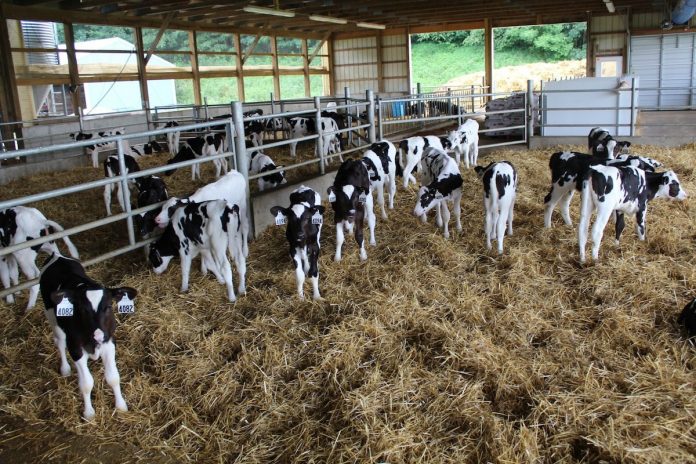Last week the north winds began to blow bringing in cold arctic air. As we dug out the barn door so that they would close, we were reminded of the many things we needed to prepare so that our calves were ready for winter.
The thermoneutral zone for calves is 50-68⁰F, meaning when temperatures in their environment are below the lower critical temperature of 50⁰F, they need extra energy to stay warm. This can be a challenge since 50⁰F night may have highs over 70⁰F during the day. Usually, calves deep bedded with straw manage this variation by nesting with their legs coved at least to the middle of the back leg when lying down.
Calf jackets
The next step is adding calf jackets to help keep calves warm. Studies show that calf jackets improve gain by 0.22 pounds per day compared to those without jackets. Adding jackets when it is warm out may cause the calves to sweat under the jacket and get chills at night. If you have a calf born premature, putting the jacket on at night and off during the day is extra work but may help calves who cannot regulate temperature very well.
The calf jacket material should be breathable with a water-resistant shell. It is recommended that producers start using jackets once the pen temperature averages less than 50⁰F for newborn calves up to three weeks old. Once calves are over three weeks of age, they are comfortable until average pen temperatures are below 40⁰F. The lower critical temperature continues to decrease as the calf’s rumen develops, creating heat to keep them warm.
One important management step with calf jackets is to keep the jackets dry, which means calves should be dry before putting jackets on. If the calf is still damp, you will need to change jackets after a few hours. In order to put jackets on dry calves, you should have clean towels to dry the calves. One thing that works very well when calving barn temperatures fall below freezing, or even 40⁰ F, is to have towels in a cabinet in the calving pen to help the cow dry the calf quickly. When calves are first born and they start shivering, they are burning precious energy.
Warm water bath
If newborn calves happen to get frosted/frozen the best way to warm them up is by using a warm water bath. The water should be 100-105°F, if the water is over 115°F damage can be done to the calf’s skin. As soon as the calf is warmed up it should be completely dried and fed four quarts of colostrum to help it create its own heat.
Warm boxes
Warm boxes or rooms can also be used to warm and dry calves but they need to be monitored to be sure they are actually moving enough air to help dry the calf and warm it up. Sometimes under cold conditions, the boxes don’t get warm enough leaving calves to shiver instead of warm up.
For each 1-degree drop in temperature below the lower critical temperature, a calf needs a 1% increase in energy to maintain maintenance requirements. Regardless of the milk feed program, more milk solids have to be fed without a solids concentration exceeding 16%.
Add a feeding
The most common way to increase energy intake is to feed either more per feeding or add a third feeding. While 8 hours apart is ideal for three feedings, the most important part is to make timing consistent. Feed the same amount at each feeding, even if that means adding a lunch feeding between your normal feeding times. Another beneficial practice is to provide warm water at 63-82⁰F to calves within 30 minutes of finishing their milk. Water intake improves starter intake by 31%.
Avoiding diseases
Winter ventilation is critical to calf health but takes a lot more work than summer ventilation. Keeping barns or hutches warm is not really the goal. Keeping the air fresh to minimize disease while not allowing a draft on the calves is the goal. There are many ways to do this.
With hutches, it usually means having either permanent winter windbreaks or temporary windbreaks, like straw bales. In calf barns, pens are a microenvironment affected by ventilation and pen design. Studies have found that solid sides slow disease spread but are only beneficial if the front, back and top of the pens are open, otherwise, they create a high disease microenvironment. When disease and ventilation is challenging your calves, a properly designed positive pressure tube providing ventilation at a rate of 15 cubic feet/calf/minute can improve calf health without creating a chill.













